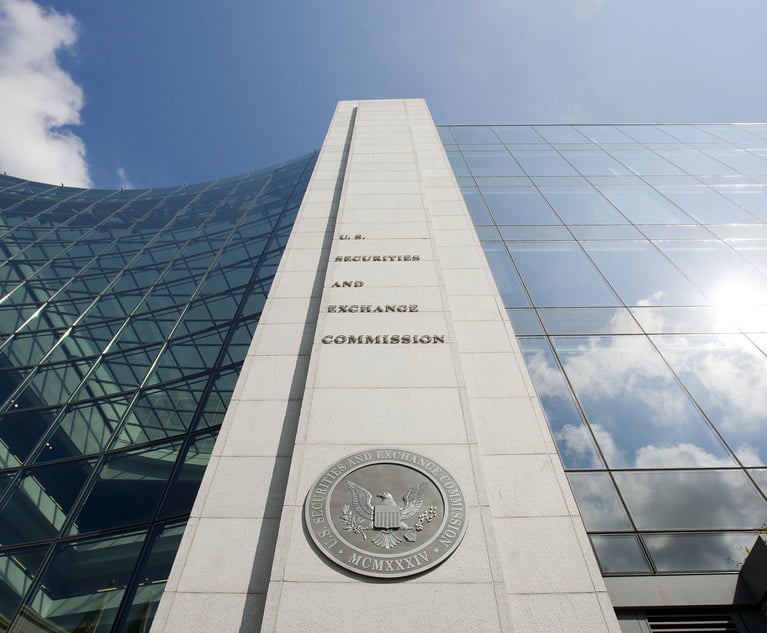Litigation: Examining the False Claims Act and civil investigative demands
Nearly every in-house counsel has dealt with a subpoena at one time or another. But less well known is an increasingly common tool used by the government: the civil investigative demand.
September 05, 2013 at 06:47 AM
4 minute read
The original version of this story was published on Law.com
Nearly every in-house counsel has dealt with a subpoena at one time or another. But less well known is an increasingly common tool used by the government: the civil investigative demand (CID). Several federal and state statutes grant the government authority to issue CID authority. For example, at the federal level, CIDs can be issued by DOJ when investigating antitrust violations and civil racketeering. Other agencies have similar power, such as the FTC in deceptive trade practices investigations and the newly created Consumer Financial Protection Bureau in financial services investigations as authorized by § 1052 the Dodd-Frank Act.
The most common type, however, is associated with the civil False Claims Act (FCA), which grants broad CID powers. The power and frequency of FCA CIDs has grown in conjunction with DOJ's current use of the FCA as its chief weapon against civil fraud.
Since its enactment in 1863, the FCA's scope has grown significantly, as has prosecutors' aggressive theories for what constitutes a “false claim.” The statute underwent a major overhaul in 1986, which increased its penalties and first granted CID authority in FCA investigations. That authority, however, was severely limited because only the Attorney General could approve issuance of CIDs. Because of the bureaucratic difficulty of obtaining such approval, line prosecutors used CIDs sparingly.
That changed in 2009 with the passage of the Fraud Enforcement and Recovery Act, which enabled the Attorney General to delegate to U.S. attorneys the power to issue CIDs. Since then, use of CIDs has increased significantly, as has DOJ's recoveries under the FCA. In 2012 alone, DOJ recovered a record-breaking $4.9 billion in FCA settlements and judgments, while it has recovered over $13 billion since 2009.
What is a CID?
A CID is like beefed-up subpoena. While a subpoena duces tecum will only call for production of documents, a CID can require the recipient to produce documents, as well as answer interrogatories or give oral testimony under oath. Moreover, the authority to issue a CID is quite broad. The issuing prosecutor merely must have “reason to believe that any person may be in possession, custody, or control of documentary material or information relevant to a false claims law investigation.” The potential breadth of a CID and the ability to compel sworn testimony raise critical issues for recipients, particularly those who may be under a concurrent criminal investigation. And unlike interrogatories or depositions in a civil case, CIDs are an investigative, not discovery, tool, so only the government gets to use them.
Some notable features
Although they are investigative tools, CIDs are similar to various types of discovery requests in civil litigation. There are, however, some notable features of the CID statute, as well as some yet unresolved ambiguities:
- Persons present at oral examinations: Section 3733(h)(2) addresses who may be present at the oral examination of a witness. Of particular note for corporate counsel, this includes the “attorney and any other representative” of the witness (emphasis added). This suggests that when a witness is testifying as a corporate representative, a company representative can be present in addition to the witness's lawyer.
- Transcripts: Several sections in the statute address transcripts. Every witness has the right to examine and make changes to the transcript before signing. Likewise, witnesses are entitled to a copy of transcript, except where the “Attorney General, the Deputy Attorney General, or an Assistant Attorney General” limits access for good cause. That should be a high hurdle, and practitioners faced with such a claim should insist on a clear record of which enumerated official made the determination and the basis for the good cause.
- Future use: The CID statue is clear that, although its authority derives from the FCA, the material produced can be used in other proceedings, including criminal ones. In fact, any DOJ attorney who is appearing before any court, grand jury, or federal agency in any proceeding can receive the material, answers, or transcripts obtained via a CID. In this sense, a CID allows greater latitude to prosecutors than a grand jury subpoena because material obtained through a CID does not have the use restrictions that grand jury material does. As noted, this has particularly critical effect on companies or individuals who may also be subject to a parallel criminal investigation, and counsel will want to carefully consider the 5th Amendment implications that can arise.
With no signs of FCA enforcement abating, counsel for companies in regulated areas – especially health care, financial services, and government contractors of all types – are likely to see even more use of the FCA CIDs in years to come.
This content has been archived. It is available through our partners, LexisNexis® and Bloomberg Law.
To view this content, please continue to their sites.
Not a Lexis Subscriber?
Subscribe Now
Not a Bloomberg Law Subscriber?
Subscribe Now
NOT FOR REPRINT
© 2025 ALM Global, LLC, All Rights Reserved. Request academic re-use from www.copyright.com. All other uses, submit a request to [email protected]. For more information visit Asset & Logo Licensing.
You Might Like
View All

‘Extremely Disturbing’: AI Firms Face Class Action by ‘Taskers’ Exposed to Traumatic Content
5 minute read
In-House Lawyers Are Focused on Employment and Cybersecurity Disputes, But Looking Out for Conflict Over AI
Trending Stories
- 1Treasury GC Returns to Davis Polk to Co-Chair White-Collar Defense and Investigations Practice
- 2Decision of the Day: JFK to Paris Stowaway's Bail Revocation Explained
- 3Doug Emhoff, Husband of Former VP Harris, Lands at Willkie
- 4LexisNexis Announces Public Availability of Personalized AI Assistant Protégé
- 5Some Thoughts on What It Takes to Connect With Millennial Jurors
Who Got The Work
J. Brugh Lower of Gibbons has entered an appearance for industrial equipment supplier Devco Corporation in a pending trademark infringement lawsuit. The suit, accusing the defendant of selling knock-off Graco products, was filed Dec. 18 in New Jersey District Court by Rivkin Radler on behalf of Graco Inc. and Graco Minnesota. The case, assigned to U.S. District Judge Zahid N. Quraishi, is 3:24-cv-11294, Graco Inc. et al v. Devco Corporation.
Who Got The Work
Rebecca Maller-Stein and Kent A. Yalowitz of Arnold & Porter Kaye Scholer have entered their appearances for Hanaco Venture Capital and its executives, Lior Prosor and David Frankel, in a pending securities lawsuit. The action, filed on Dec. 24 in New York Southern District Court by Zell, Aron & Co. on behalf of Goldeneye Advisors, accuses the defendants of negligently and fraudulently managing the plaintiff's $1 million investment. The case, assigned to U.S. District Judge Vernon S. Broderick, is 1:24-cv-09918, Goldeneye Advisors, LLC v. Hanaco Venture Capital, Ltd. et al.
Who Got The Work
Attorneys from A&O Shearman has stepped in as defense counsel for Toronto-Dominion Bank and other defendants in a pending securities class action. The suit, filed Dec. 11 in New York Southern District Court by Bleichmar Fonti & Auld, accuses the defendants of concealing the bank's 'pervasive' deficiencies in regards to its compliance with the Bank Secrecy Act and the quality of its anti-money laundering controls. The case, assigned to U.S. District Judge Arun Subramanian, is 1:24-cv-09445, Gonzalez v. The Toronto-Dominion Bank et al.
Who Got The Work
Crown Castle International, a Pennsylvania company providing shared communications infrastructure, has turned to Luke D. Wolf of Gordon Rees Scully Mansukhani to fend off a pending breach-of-contract lawsuit. The court action, filed Nov. 25 in Michigan Eastern District Court by Hooper Hathaway PC on behalf of The Town Residences LLC, accuses Crown Castle of failing to transfer approximately $30,000 in utility payments from T-Mobile in breach of a roof-top lease and assignment agreement. The case, assigned to U.S. District Judge Susan K. Declercq, is 2:24-cv-13131, The Town Residences LLC v. T-Mobile US, Inc. et al.
Who Got The Work
Wilfred P. Coronato and Daniel M. Schwartz of McCarter & English have stepped in as defense counsel to Electrolux Home Products Inc. in a pending product liability lawsuit. The court action, filed Nov. 26 in New York Eastern District Court by Poulos Lopiccolo PC and Nagel Rice LLP on behalf of David Stern, alleges that the defendant's refrigerators’ drawers and shelving repeatedly break and fall apart within months after purchase. The case, assigned to U.S. District Judge Joan M. Azrack, is 2:24-cv-08204, Stern v. Electrolux Home Products, Inc.
Featured Firms
Law Offices of Gary Martin Hays & Associates, P.C.
(470) 294-1674
Law Offices of Mark E. Salomone
(857) 444-6468
Smith & Hassler
(713) 739-1250







